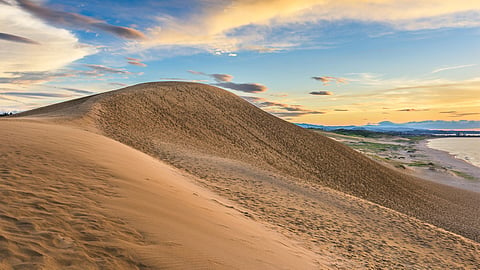
- Destinations
- Experiences
- Stay
- What's new
- Celebrating People
- Responsible Tourism
- CampaignsCampaigns
- Subscribe
- Buy Now

Set in Tottori Prefecture on Honshu’s west coast, the Tottori Sand Dunes (Tottori Sakyū) are the largest sand dunes in Japan. They extend roughly 16 km east-to-west along the coast and up to 2.4 km north-to-south, with dunes that can rise to about 50 m in height. These sweeping sands are part of the San’in Kaigan National Park and are designated both a National Natural Monument and a UNESCO Global Geopark.
The dunes were formed over more than 100,000 years—sand washed down from the Chūgoku Mountains via the Sendai River, deposited into the Sea of Japan, then pushed back inland by currents and seasonal winds. Over time, shapes like bowl-depressions called suribachi, wind ripples (fumon), and curving ridges (for example Umanose, “Horse’s Back”) have evolved. The patterns of wind and sand, especially in early morning or at sunset, create dramatic visual landscapes that shift daily.
But this natural wonder is changing. Over the past century, the dunes have shrunk significantly—due to afforestation (tree planting), coastal development, sediment trapping by dams and other river or shore modifications. Invasive plants have also crept in over recent decades, disrupting sand flow and altering the dune structure. Local authorities and community groups have responded with preservation efforts: removing invasive vegetation, replenishing sand, restricting damaging activities, and establishing the Visitor Center and regulations to protect the dunes.
Visitors to the dunes will find more than just sweeping sand vistas.
Visitor Center: The Tottori Sand Dunes Visitor Center is a must-first stop. It has interactive displays on geology, flora and fauna, and sand patterns, and shows videos about how the dunes change with seasons. It’s wheelchair-accessible, free to enter, and offers facilities like foot-showers, maps, and multilingual information.
Sand Museum: Near the dunes, this indoor museum features large sand sculptures by international artists. Exhibitions change annually, each themed around a different country or region.
Adventure & Scenic Activities: Think sandboarding, paragliding, camel rides, and even horse-drawn or “camel-style” tours across the dunes. For panoramic views, climbs up vantage points like Umanose are especially rewarding.
Eco-tourism & Volunteering: To help protect the dunes, there are community weeding sessions (especially in summer) where visitors can join locals to remove invasive species. It adds meaning to the visit and supports conservation.
The dunes are about 20 minutes by local bus from Tottori Station; taxis are also available but costlier. The best times to visit are spring, early summer or autumn, when the weather is milder, skies are clearer, and the sand forms beautiful patterns. Early morning or just before sunset offer the best lighting for photography. Avoid peak noon hours in summer or heavy snow in winter if you want an easier walk.
With ongoing erosion, invasive vegetation, coastal changes, and human development, this dune landscape is under threat. Preservation efforts are ongoing, but the dunes’ shape, size, and ecology are gradually changing. Visiting now doesn’t just offer spectacular scenery—it helps support local conservation, cultural identity, and awareness of Japan’s fragile natural heritage.
The Tottori Sand Dunes are in Tottori Prefecture on the western coast of Japan’s Honshu Island, along the Sea of Japan. They are part of the San’in Kaigan National Park and lie just a short distance from Tottori City.
The Tottori Sand Dunes are Japan’s largest dune system, stretching over 16 kilometres. Formed over 100,000 years by river and wind activity, they offer a unique desert-like landscape in Japan. Visitors can enjoy sandboarding, paragliding, camel rides, and explore the Sand Museum nearby.
You can reach the dunes by taking a local bus (about 20 minutes) from Tottori Station. Direct trains from Osaka, Kyoto, or Okayama connect to Tottori City. Taxis and car rentals are also available for those preferring flexible travel.
The best time to visit is spring (March–May) and autumn (September–November), when the weather is mild and the skies are clear. Early mornings and sunset hours offer the most beautiful dune patterns and photo opportunities.
Yes, the dunes are gradually shrinking due to vegetation growth, dam construction, and coastal changes. Local authorities have launched preservation efforts such as weeding programs, sand restoration, and eco-volunteer activities to protect this fragile landscape.
